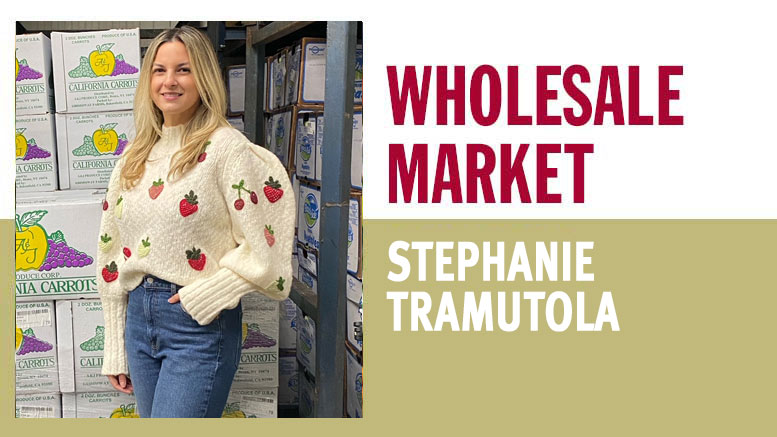Maximizing Produce to its Full Potential
May 28, 2024 | 4 min to read
As a wholesaler at A&J Produce Corp., we prioritize maximizing the shelf life and quality of every piece of produce by employing rigorous inspection, proper storage, and temperature regulation. Operating under the highest food safety standards, our team ensures that the fresh produce, sourced globally, is meticulously handled to maintain its integrity. With a focus on efficiency and rapid turnover, we strive to prevent waste while delivering the best possible quality to our customers.

Originally printed in the April 2024 issue of Produce Business.
As a wholesaler, we are in a position to maximize every piece of produce that we receive, never sacrificing quality. This is to ensure our customers can be confident that they will be given the freshest and healthiest produce available on any given day.
It is our duty to make sure we take every necessary step in extending the shelf life and condition of each fruit and vegetable that enters our warehouse in the Hunts Point Terminal Produce Market in Bronx, NY.
Actions such as temperature recording and regulation, inspection, proper storage, and time of sale are all essential for preserving and maintaining the shelf life of produce.
We are the first stop after the farm, ensuring little to no interruption occurs to protect the quality of produce. Given our broad spectrum of growers and shippers (we receive produce from around the world), our job starts before the produce gets to us.
The process begins when the produce is loaded from the grower or shipper. Temperature recorders are placed on the method of transportation, typically a “reefer” truck, a refrigerated trailer to transport perishables and other temperature-sensitive goods, to confirm produce items are regulated and stored properly while in transit.
These recorders are satellite-connected with temperature and location updated instantaneously. If there happens to be any temperature issue, we can notify the transportation company of any modifications or recalibrations necessary while in transit.
Once the produce arrives at our loading dock, we get it into our warehouse as soon as possible. At A&J, our warehouse is completely modernized and in compliance with the highest level of food safety standards and regulations, known as SQF (Safe Quality Food), guaranteeing the cold chain is never broken. Produce is then inspected thoroughly by our quality assurance team, making sure the product that has just traveled maintains its original form from the farm.
Wholesalers are the intermediaries from farm to table — a crucial step in the supply chain, making sure the shelf life of any given produce item is maximized.
We look for any and all defects on each item and then translate that information into percentages. This includes, for example, curd discoloration (cauliflower), wilting and russet spotting (brown leaves on lettuce), bruising (berries), abnormal coloring (tomatoes), decay affecting compact portion of heads or butts (iceberg lettuce), dry and soft rot (potatoes), yellowing or decaying bud clusters (broccoli), and wilting (leafy green specific).
If there is a situation in which the percentages are scored above the maximum allowed, the shipper is notified immediately. If the product passes inspection, it is then placed correctly in a temperature-controlled cooler.
Depending on the produce item, different temperatures are set for each fruit or vegetable. For example, strawberries are maintained at a consistent temperature of 36 degrees Fahrenheit. This is very different than a tomato, avocado, or tropical items such as mangos and pineapples, which are stored at a higher temperature around 45-50 degrees Fahrenheit.
Storage at the correct temperature, in addition to the actual placement of items in the warehouse, is extremely important, as certain items, if stored together, can cause the immature ripening of one another. Extending produce shelf life relies heavily on proper storage.
Once in our warehouse, it is our job as a wholesaler to make sure the time of sale is perfectly executed. Given the lifespan of produce, the effort to move items is always made efficiently and effectively. This is a 24-hour business, and the turnover rate is high, keeping our product as fresh as possible for our customers.
Items we see that have a shorter shelf life include wet vegetables such as leafy greens, lettuce, mesclun, arugula and berries. On the contrary, items such as potatoes, which are kept in dry storage and not refrigerated, have a longer shelf life. Time is of the essence when dealing with perishable items.
What happens when produce is nearing the end of its lifespan? This is where our expertise comes into play as a wholesaler. We do everything in our power as produce ages to sell at the best possible price to make a profit, ensuring every item finds an outlet that is beneficial. Each fruit and vegetable must be in perfect condition before it becomes “waste,” and with generations in the trade, the knowledge we have limits any item deemed undesirable.
Wholesalers are the intermediaries from farm to table — a crucial step in the supply chain, making sure the shelf life of any given produce item is maximized. Our customers always receive the freshest produce that is properly handled, inspected, and stored to guarantee the highest standard.
Our role is critical in utilizing each fruit or vegetable item to its fullest potential, with taste and quality always at the forefront.

Stephanie Tramutola is the first female in the family to be working at A&J Produce Corp., Bronx, NY. The company was started in 1977 by her grandfather, John Tramutola, and his partners. Today, A&J Produce is one of the largest wholesalers of fresh fruit and vegetables in the Hunts Point Terminal Market, servicing New York and the northeast region.
5 of 15 article in Produce Business May 2024

